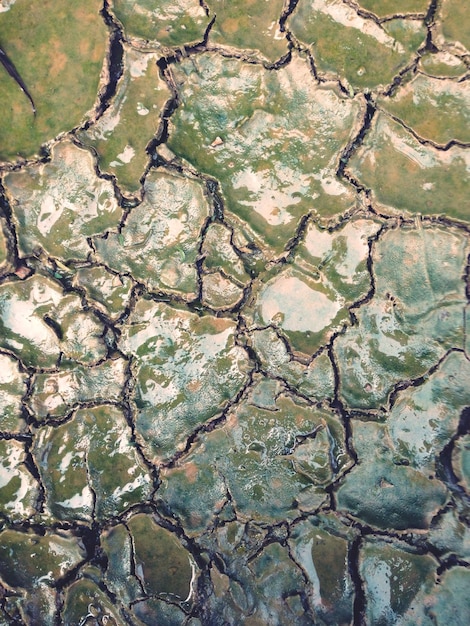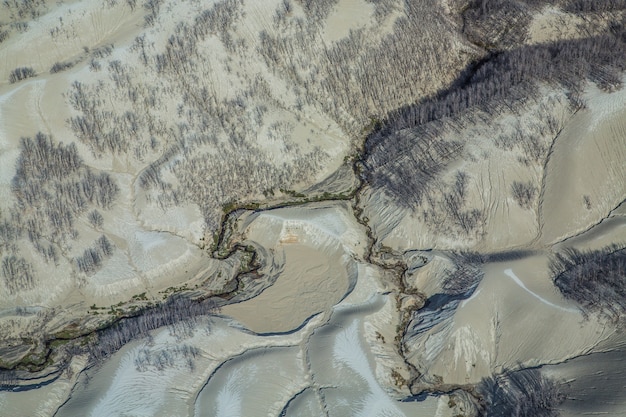US water scarcity risks: What to expect by 2030

Projections indicate that by 2030, the United States faces heightened water scarcity risks driven by climate change-induced droughts, unsustainable agricultural practices, increasing population demands, deteriorating infrastructure, and inadequate policy frameworks, threatening economic stability and environmental health across key regions.
Understanding what are the projected water scarcity risks in the US by 2030 is not merely an academic exercise; it’s a critical assessment of the nation’s future resilience. As we approach the end of the decade, a confluence of environmental shifts, demographic pressures, and aging infrastructure paints a complex picture for water availability across the United States. This article delves into the multi-faceted challenges and potential impacts of these impending water shortages.
The Looming Threat of Climate Change and Prolonged Droughts
Climate change stands as the primary accelerator of water scarcity across the United States. Shifting weather patterns, exacerbated by global warming, are leading to more frequent and intense droughts, particularly in the historically arid Western and Southwestern states. These aren’t just dry spells; they represent a fundamental alteration of hydrological cycles, affecting everything from snowpack accumulation to groundwater replenishment.
The Colorado River Basin, a vital water source for over 40 million people in seven states and parts of Mexico, offers a stark example. Decades of drought, intensified by rising temperatures, have significantly depleted its major reservoirs, Lake Mead and Lake Powell, to historically low levels. This depletion threatens hydropower generation, municipal water supplies, and agricultural production across the region, necessitating unprecedented cuts in water allocations.

Impacts of Decreased Snowpack
Mountain snowpack acts as a natural reservoir, gradually releasing water into rivers and streams during warmer months. However, rising temperatures mean more precipitation falls as rain instead of snow, and existing snowpack melts earlier in the season. This alters the timing and volume of water availability, leading to:
- Reduced River Flows: Lower summer river levels impact aquatic ecosystems, municipal water treatment, and navigation.
- Earlier Runoff: Water becomes available when demand might be lower, leading to increased evaporation or difficulty in storage.
- Diminished Reservoir Inflows: Reservoirs rely heavily on snowmelt, and its reduction directly translates to less stored water for critical periods.
Beyond the West, regions like the Great Plains and parts of the Southeast are also experiencing more intense and prolonged droughts. These events stress agricultural systems, lead to increased wildfire risks, and strain already limited water infrastructure. The variability makes future planning exceptionally challenging, forcing communities to rethink long-held assumptions about water security.
The science is clear: a warmer climate means a thirstier landscape and a less reliable water supply. Communities must adapt to this new reality, investing in resilient water systems and innovative conservation strategies to mitigate the escalating risks.
Unsustainable Agricultural Practices and Water Intensive Crops
Agriculture remains the largest consumer of fresh water in the United States, accounting for approximately 80% of the nation’s consumptive water use, and up to 90% in some Western states. The current practices in many agricultural regions, combined with the cultivation of specific water-intensive crops, are major contributors to projected water scarcity by 2030. This heavy reliance on irrigation, often from dwindling surface and groundwater sources, is pushing many hydrological systems to their limits.
Many traditional farming methods use flood irrigation, which is highly inefficient, losing significant amounts of water to evaporation and runoff. While drip irrigation and other precision agriculture techniques are gaining traction, their adoption is not yet widespread enough to offset the immense water demands of the sector. The economic incentives often favor maximizing yields over conserving water, creating a difficult paradox to resolve.
Regional Crop Focus and Water Footprint
The cultivation of certain crops disproportionately impacts regional water budgets. For instance, alfalfa, a common feed crop for livestock, is incredibly water-intensive and widely grown in arid states like California and Arizona, further stressing already over-allocated water sources. Similarly, while almonds are a valuable export, their cultivation in California’s Central Valley requires substantial irrigation. This regional specialization in water-heavy crops exacerbates local water stress.
- Alfalfa: High water use for livestock feed, prevalent in drought-prone areas.
- Cotton: A thirsty crop, contributing to water depletion in southern states.
- Rice: Requires flooded fields, making it water-intensive where grown.
- Nut Crops (e.g., Almonds): Perennial crops with significant water demands, particularly in California.
The depletion of aquifers, such as the Ogallala Aquifer beneath the Great Plains, illustrates the long-term consequences of unsustainable agricultural water use. This vital underground reservoir, which supports a significant portion of agricultural production, is being drawn down much faster than it can be replenished. By 2030, this trend could lead to widespread well failures, increased pumping costs, and a fundamental shift in agricultural viability for many communities dependent on it.
Addressing agricultural water use requires a multi-pronged approach, including promoting widespread adoption of water-efficient irrigation, incentivizing shifts to less water-intensive crops in drought-prone regions, and developing market-based solutions that reflect the true value of water. Without significant changes, agriculture’s water footprint will continue to be a primary driver of scarcity.
Aging Infrastructure and Water Loss
The United States’ vast water infrastructure, much of which was built decades ago, is steadily deteriorating, contributing significantly to water scarcity through leaks, breaks, and inefficiencies. Pipes, treatment plants, and distribution networks require substantial investment, yet deferred maintenance and underfunding have become common, leading to preventable water loss on a massive scale. This hidden crisis means that even when water is available at its source, a considerable amount never reaches its intended destination due to crumbling systems.
Estimates suggest that millions of gallons of treated drinking water are lost daily through leakage in municipal distribution systems. These “non-revenue water” losses not only represent a waste of a precious resource but also increase the cost of water for consumers, as utilities must treat and pump more water than is actually delivered. Beyond the financial implications, these losses mean less water is available for use, intensifying scarcity even in areas not directly impacted by drought. The problem extends beyond pipes to include outdated treatment facilities and pumping stations that consume excessive energy, adding to the operational burden.

Consequences of Infrastructure Degradation
The pervasive issue of aging infrastructure brings several critical consequences that heighten water scarcity risks:
- Significant Water Loss: Leaks in pipes, valves, and reservoirs lead to substantial daily water waste, often unnoticed.
- Contamination Risks: Cracks in pipes can allow contaminants to enter the drinking water supply, posing health risks and requiring extensive remediation.
- Increased Energy Consumption: Inefficient pumps and treatment processes necessitate more energy, raising operational costs and carbon footprints.
- Service Interruptions: Pipe breaks can cause widespread service outages, disrupting daily life and requiring costly emergency repairs.
Furthermore, the maintenance and upgrade of this infrastructure are incredibly expensive, often beyond the financial capacity of many local municipalities. Federal funding programs have historically been insufficient to meet the scale of the problem. Without a concerted national effort and sustained investment, the infrastructure deficit will continue to undermine efforts to secure water supplies. By 2030, areas with particularly old or neglected systems will face disproportionately higher risks of water service interruptions and exacerbated water stress.
Investing in modern, resilient water infrastructure is not just about preventing leaks; it’s about building a sustainable future. Smart water technologies, real-time monitoring, and proactive maintenance programs are essential to reduce losses and ensure that every drop counts in an increasingly water-stressed nation.
Population Growth and Urbanization Pressures
The projected population growth and continued urbanization trends across the United States pose significant challenges for water resource management by 2030. As more people move into already water-stressed regions, the demand for residential, commercial, and industrial water increases exponentially, often outpacing the available supply. This demographic shift intensifies pressure on existing water sources, leading to heightened competition among users and a greater strain on fragile ecosystems.
Many of the fastest-growing metropolitan areas, such as those in the Southwest and parts of the Southeast, are located in naturally arid or semi-arid environments. The sprawling nature of urban development, often characterized by water-intensive landscaping and lifestyle choices, further compounds the problem. Developers and city planners face the dilemma of meeting housing demands while ensuring sufficient water availability, a balance becoming increasingly difficult to achieve without significant policy changes and technological advancements.
Regional Growth Hotspots and Water Demand
Specific regions are expected to experience disproportionate pressure from population growth, directly impacting their water security:
- Southwest: Cities like Phoenix, Las Vegas, and many in California continue to grow rapidly in areas with limited local water sources, relying heavily on interstate water transfers.
- Southeast: While generally wetter, booming coastal and inland cities are stressing local groundwater aquifers and river systems, leading to localized scarcity issues.
- Texas: Rapid urbanization in major metro areas like Dallas-Fort Worth, Houston, and Austin is increasing water demand amidst variable rainfall and reliance on diverse, often over-allocated, sources.
The challenge isn’t just about total population; it’s also about lifestyle and consumption patterns. As incomes rise, so too often does per capita water use, driven by larger homes, more amenities, and water-intensive industries. Addressing this requires a combination of smart urban planning, promoting water-efficient appliances and landscaping, and implementing tiered water pricing to incentivize conservation. Without these measures, cities will increasingly face difficult choices regarding water allocation, potentially leading to social and economic tensions.
By 2030, many urban centers will need to creatively expand their water portfolios through aggressive water recycling, stormwater capture, and innovative conservation programs. Relying solely on traditional surface and groundwater sources will become untenable, highlighting the urgent need for a paradigm shift in how urban populations manage and value their most fundamental resource.
Inadequate Policy Frameworks and Interstate Water Disputes
The current water management policies in the United States, often fragmented and rooted in historical precedent rather than contemporary ecological realities, are proving inadequate to address escalating scarcity risks by 2030. Many water rights systems, particularly in the Western U.S., operate on “first in time, first in right” principles, which grant senior water rights holders preference, even during droughts. This can leave junior rights holders, often including municipalities and environmental flows, vulnerable to severe cutbacks and exacerbates overall shortage conditions.
State-level variation in water laws and the transboundary nature of many major river basins also complicate effective management. Rivers like the Colorado, Rio Grande, and Mississippi flow through multiple states, leading to complex interstate compacts and frequent disputes over water allocation. Climate change, by reducing overall river flows, intensifies these disputes, as there is simply less water to apportion among competing demands. The legal and political frameworks often lag behind the rapid pace of environmental change and the increasing pressures of population growth.
Challenges in Policy Implementation and Enforcement
Beyond the legal framework, the practical implementation and enforcement of water policies face several hurdles:
- Lack of Integrated Management: Surface water and groundwater are often managed separately, despite being hydrologically connected, leading to uncoordinated and unsustainable withdrawals.
- Insufficient Funding for Regulatory Bodies: Water agencies often lack the resources to effectively monitor water use, enforce regulations, and invest in necessary data collection.
- Political Resistance to Change: Reforming long-standing water rights and reducing allocations often faces strong political opposition from entrenched interests, including agricultural lobbies and established industries.
- Limited Emphasis on Conservation: While some states have made progress, a nationwide aggressive push for water conservation through regulation and incentives is still lacking in many areas.
The absence of a cohesive national water strategy, combined with the fragmented nature of state and local water governance, creates significant systemic vulnerabilities. By 2030, these policy shortcomings will likely lead to increased litigation, economic disruptions, and a greater reliance on emergency measures rather than proactive planning. Solutions require moving beyond traditional legal battles to foster greater interstate and inter-agency collaboration, embracing adaptive management strategies, and prioritizing sustainable water use over historical entitlements.
Policy reform must also integrate climate science, acknowledging that past averages are no longer reliable indicators for future water availability. This requires flexible allocation mechanisms, robust data infrastructure for real-time monitoring, and investment in water market mechanisms that can help allocate water more efficiently during times of stress.
Groundwater Depletion and Contamination
Groundwater, often seen as a reliable buffer against surface water shortages, is facing unprecedented depletion and contamination across the United States, escalating water scarcity risks by 2030. Aquifers, the underground layers of permeable rock that hold groundwater, are being pumped faster than they can naturally replenish, particularly in major agricultural regions and rapidly growing urban areas. This unsustainable over-extraction has profound long-term consequences, undermining a critical component of the nation’s water security.
The depletion manifests in several ways: falling water tables, increased pumping costs, land subsidence (the sinking of the ground), and the degradation of groundwater quality. In coastal areas, excessive pumping can lead to saltwater intrusion, rendering freshwater aquifers unusable for drinking or irrigation. This is a irreversible process, effectively eliminating a vital water source for generations, a risk that is becoming increasingly real by 2030 in states like Florida and California.
Key Drivers of Groundwater Problems
- Agricultural Over-pumping: Irrigation for crops is the largest consumer of groundwater, particularly in the Great Plains (Ogallala Aquifer) and California’s Central Valley.
- Urban and Industrial Demand: Growing cities and manufacturing industries rely heavily on groundwater, especially during drought conditions when surface water sources are stressed.
- Pollution from Various Sources: Agricultural runoff (pesticides, fertilizers), industrial waste, leaking septic systems, and faulty infrastructure can contaminate aquifers, rendering the water unsafe.
- Climate Change Impacts: Reduced surface water availability due to drought increases reliance on groundwater, accelerating depletion rates when natural recharge is also diminished.
Beyond quantity, groundwater quality is also a growing concern. Contaminants from agricultural runoff, industrial spills, and even naturally occurring elements like arsenic can seep into aquifers, making the water unsafe for consumption without extensive and costly treatment. Addressing this requires stricter regulations on pollutant discharge, improved land management practices, and significant investment in water treatment technologies. The effects of contamination are often long-lasting and difficult to remediate, locking in future water scarcity even if water levels were to somehow recover.
By 2030, many communities reliant on groundwater will face stark choices: either invest heavily in costly new wells and treatment systems or seek alternative, often more expensive, water sources. Sustainable groundwater management, including strict pumping limits, artificial recharge projects, and robust monitoring programs, is crucial to preserving this vital resource for future generations. Without proactive measures, the nation’s underground water reserves will be increasingly unable to serve as a reliable safety net against surface water shortages.
Economic and Social Repercussions
The projected water scarcity risks in the US by 2030 extend far beyond environmental concerns, promising profound economic and social repercussions across the nation. Water is a foundational input for nearly all economic activity, from agriculture and manufacturing to energy production and tourism. Disruptions to its supply can trigger cascading failures throughout various sectors, leading to job losses, reduced productivity, and increased commodity prices. The social fabric of communities heavily reliant on water can also fray under persistent shortages and the difficult decisions they necessitate.
Agriculture, as the largest water user, is particularly vulnerable. Crop failures due to insufficient irrigation, increased pumping costs, and forced reductions in cultivated acreage can devastatingly impact rural economies. This can lead to higher food prices for consumers nationwide, affecting household budgets, especially for low-income families. Beyond agriculture, industries that require significant water for cooling, processing, or cleaning, such as power generation, mining, and food processing, will face operational challenges, potentially leading to curtailed production or relocation of facilities.
Disproportionate Impacts and Social Equity
The burden of water scarcity often falls disproportionately on vulnerable populations and disadvantaged communities. This includes:
- Low-Income Households: Face challenges affording rising water rates or accessing bottled water during supply interruptions.
- Rural Communities: Often reliant on local wells that can run dry, lacking the resources to diversify water sources.
- Indigenous Communities: Many treaties grant water rights, but these are often not fully realized, leaving them vulnerable to shortages and water quality issues.
- Environmental Justice Communities: May be subjected to greater pollution loads and have less political power to advocate for clean water access.
Public health is another significant concern. Water shortages can strain sanitation systems, increase the risk of waterborne diseases, and exacerbate respiratory illnesses due to increased dust and wildfires. The stress of living with uncertain water supplies can also contribute to mental health challenges and community instability. Inter-state and intra-state conflicts over water allocation are also likely to intensify by 2030, potentially leading to prolonged legal battles and political tensions, diverting resources from other critical needs.
Mitigating these economic and social risks requires proactive planning, diverse water portfolios, and policies that ensure equitable access to water. Investing in water efficiency, resilient infrastructure, and adaptive agricultural practices can help buffer against the worst impacts. Ultimately, the ability to manage water scarcity will determine the economic vitality and social well-being of many American communities in the coming years.
| Key Factor | Brief Description |
|---|---|
| ☀️ Climate Change & Droughts | Increased frequency and intensity of droughts, reducing surface water and snowpack. |
| 👨🌾 Agricultural Practices | Inefficient irrigation and water-intensive crops deplete aquifers and rivers. |
| ⚙️ Aging Infrastructure | Leaking pipes and outdated systems lead to significant water loss. |
| 🏙️ Population & Urbanization | Growing cities increase demand, stressing existing natural water sources. |
Frequently Asked Questions About US Water Scarcity
The Western and Southwestern US, including states like California, Arizona, and Nevada, face the highest risks due to persistent droughts and reliance on over-allocated river systems like the Colorado River. Parts of the Great Plains, Southeast, and Texas also face increasing pressure from groundwater depletion and growing urban demand.
Agriculture is the largest consumer of water in the US, with inefficient irrigation methods and cultivation of water-intensive crops (like alfalfa and cotton) leading to significant water depletion. This over-extraction often strains regional aquifers and surface water bodies, particularly in agricultural hubs, accelerating scarcity.
Deteriorating pipes and outdated water delivery systems lose millions of gallons of treated water daily through leaks. This “non-revenue water” represents a significant waste of a valuable resource, exacerbating shortages and increasing costs for utilities and consumers, even in areas not directly affected by drought.
Yes, but it requires significant reform. Current fragmented policies and outdated water rights systems often hinder integrated management. Implementing adaptive policies, promoting interstate cooperation, investing in sustainable infrastructure, and incentivizing conservation are crucial steps needed to effectively manage and allocate water resources.
Water scarcity can lead to higher food prices, increased utility costs, and potential job losses in water-dependent industries. It also poses public health risks, strains municipal services, and can intensify social and political tensions over resource allocation, affecting overall economic stability and community well-being.
Conclusion
The comprehensive analysis of what are the projected water scarcity risks in the US by 2030 reveals a complex and urgent challenge. Climate change, with its relentless droughts and diminished snowpack, is altering the fundamental availability of water. Simultaneously, unsustainable agricultural practices, the silent loss from aging infrastructure, and the ever-increasing demands of a growing and urbanizing population are collectively pushing the nation’s water systems to their breaking point. Inadequate policy frameworks exacerbate these issues, often lagging behind the scientific realities and hindering proactive, integrated solutions. The consequences are far-reaching, threatening not only environmental health but also economic stability and social equity across various communities. Addressing these multifaceted risks demands a concerted, multi-sectoral effort involving significant investment in resilient infrastructure, widespread adoption of water-efficient technologies, crucial reforms in water governance, and a profound shift in societal attitudes towards conservation. Only through such comprehensive and collaborative action can the United States hope to secure a sustainable water future for all its citizens beyond 2030.





